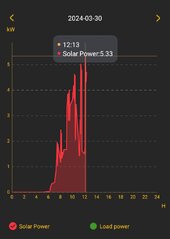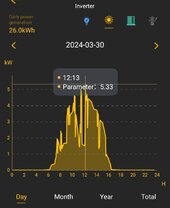Hi everyone
I'm going to add one more panel to already installed panels (9 panels and all connected in series).
The panels are of JA solar, Deep Blue 4.0, JAM66D42-580/MB bifacial N-type.
I'm unable to understand if I could hook the new panel with the existing panels in series or I have to make two strings of 5 panels each and parallel them..
Inverter Specs.
Nominal DC/Max DC= 360/500 VDC
Start up/Initial Feeding= 120/150 VDC
MPP range = 120-430 VDC
Max input Current= 27 A
No of tracker= 1
Panels specs are
VoC = 48.18
Vmp = 40.42
Isc = 15.21
Imp = 14.35
Temp Coefficient of Isc = +0.046%/°C
Temp Coefficient of Voc = -0.36%/°C
Minimum temperature that we encounter in winters is around 3°C while maximum temperature reaches 46°C in summer.
If anyone can tell if I hook all the panels in series, will the VOC of inverter be crossed of it will be in limits. And if make two strings of 5 panels each, will it exceed the Isc of inverter?
I'm going to add one more panel to already installed panels (9 panels and all connected in series).
The panels are of JA solar, Deep Blue 4.0, JAM66D42-580/MB bifacial N-type.
I'm unable to understand if I could hook the new panel with the existing panels in series or I have to make two strings of 5 panels each and parallel them..
Inverter Specs.
Nominal DC/Max DC= 360/500 VDC
Start up/Initial Feeding= 120/150 VDC
MPP range = 120-430 VDC
Max input Current= 27 A
No of tracker= 1
Panels specs are
VoC = 48.18
Vmp = 40.42
Isc = 15.21
Imp = 14.35
Temp Coefficient of Isc = +0.046%/°C
Temp Coefficient of Voc = -0.36%/°C
Minimum temperature that we encounter in winters is around 3°C while maximum temperature reaches 46°C in summer.
If anyone can tell if I hook all the panels in series, will the VOC of inverter be crossed of it will be in limits. And if make two strings of 5 panels each, will it exceed the Isc of inverter?
Last edited:




